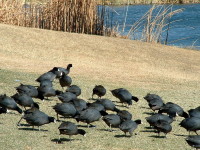 I like this image of Coots, a photo that I took several years ago while in Southern Utah. One of the reasons is that these images of nature, of living systems, remind me, or inspire me, to understand self-organizing systems. It was my friend Margaret Wheatley who spoke a premise so often when I first met her in the early 90s. “Organizations are living systems. Living systems have the capacity to self-organize. What if we were to try to organize human endeavor in the way that life organizes itself.”
I like this image of Coots, a photo that I took several years ago while in Southern Utah. One of the reasons is that these images of nature, of living systems, remind me, or inspire me, to understand self-organizing systems. It was my friend Margaret Wheatley who spoke a premise so often when I first met her in the early 90s. “Organizations are living systems. Living systems have the capacity to self-organize. What if we were to try to organize human endeavor in the way that life organizes itself.”
This focus on self-organization has much to do with complexity. My friend Kathleen Masters and I are exploring creating a workshop together. We want to give more attention to understanding complexity in complex human systems. At this point we are gathering resources.
One of those resources is from Dave Snowden, the same person that has offered so much on the Cynefin model. Kathleen reminded me recently of a distinction Snowden makes between robust systems and resilient systems. In short, it is that robust systems put a lot of energy into preventing failure. Resilient systems put a lot of energy into making it “safe to fail.”
It seems admirable on the surface, this “preventing failure” approach, doesn’t it. I don’t mind the descriptor of robust. It has typically connoted a kind of diligence, rapt attention, and preparedness. Pretty cool. The contrast in resilient systems is an acknowledgement of the essential experimental nature of complex systems, in which redundant, simultaneous experiments are happening all of the time. And many of them fail. Preventing failure restricts choices and constrains learning. Safe-to-fail expands choices and requires learning.
Snowden offers more on early detection and adaptation, which I think are helpful. But the kicker here to me is that our mindset must shift from an obsession of “get it right” to “adapt, learn, adapt, learn.” The latter welcomes, provides freedom and encouragement, to learn through failures. The former punishes it, which sadly, is common practice in in management fields.



